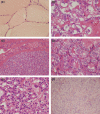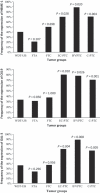Encapsulated follicular thyroid tumor with equivocal nuclear changes, so-called well-differentiated tumor of uncertain malignant potential: a morphological, immunohistochemical, and molecular appraisal
- PMID: 21070478
- PMCID: PMC11159267
- DOI: 10.1111/j.1349-7006.2010.01769.x
Encapsulated follicular thyroid tumor with equivocal nuclear changes, so-called well-differentiated tumor of uncertain malignant potential: a morphological, immunohistochemical, and molecular appraisal
Abstract
There is a continuous debate regarding the classification of thyroid follicular lesions and the term "well-differentiated tumor of uncertain malignant potential (WDT-UMP)" was recently introduced to cover this problematic spectrum of tumors. The objective of this study was to reappraise WDT-UMP using morphological, immunochemical, and molecular analysis and to shed more light on encapsulated thyroid follicular-patterned tumors. A total of 30 cases of WDT-UMP with equivocal papillary thyroid carcinoma-type nuclear changes (PTC-N) or focal unequivocal PTC-N were examined. As a control, follicular adenoma (n = 29), follicular carcinoma (n = 8), hyalinizing trabecular adenoma (n = 5), and PTC (n = 48) were included. HBME-1, cytokeratin 19, and galectin-3 were positive in 12 (40.0%), 10 (33.3%) and 11 (36.7%) cases of WDT-UMP, respectively. According to the positivity of those markers, significant differences were obtained between WDT-UMP and PTC encapsulated common type (P = 0.028, 0.010, and 0.004, respectively), infiltrative follicular variant (P = 0.020, 0.026, and 0.008, respectively), and infiltrative common type (P = 0.004, 0.001, and 0.005, respectively), but not between WDT-UMP and follicular adenoma or follicular carcinoma. BRAF(V600E) mutation was absent but RET/PTC1 rearrangement was found in only two (6.7%) cases of WDT-UMP. None of the 20 patients with WDT-UMP developed recurrence, with an average follow-up of 80 months. These findings indicate that WDT-UMP has a favorable outcome and is distinct from PTC in morphological, immunohistochemical, and molecular characteristics. We propose that WDT-UMP should be classified as "well-differentiated tumor with uncertain behavior".
© 2010 Japanese Cancer Association.
Figures





Similar articles
-
Cyclin D1 in well differentiated thyroid tumour of uncertain malignant potential.Diagn Pathol. 2015 Apr 18;10:32. doi: 10.1186/s13000-015-0262-8. Diagn Pathol. 2015. PMID: 25907675 Free PMC article.
-
Immunohistochemical and morphometrical evaluation of well-differentiated thyroid tumor of uncertain malignant potential.Indian J Pathol Microbiol. 2019 Jan-Mar;62(1):17-23. doi: 10.4103/IJPM.IJPM_199_18. Indian J Pathol Microbiol. 2019. PMID: 30706854
-
Cytological features of well-differentiated tumors of uncertain malignant potential: Indeterminate cytology and WDT-UMP.Endocr J. 2012;59(6):483-7. doi: 10.1507/endocrj.ej11-0261. Epub 2012 Apr 7. Endocr J. 2012. PMID: 22484994
-
Encapsulated papillary thyroid carcinoma, follicular variant: a misnomer.Pathol Int. 2012 Mar;62(3):155-60. doi: 10.1111/j.1440-1827.2011.02773.x. Epub 2012 Jan 30. Pathol Int. 2012. PMID: 22360502 Review.
-
Classification of thyroid follicular cell tumors: with special reference to borderline lesions.Endocr J. 2012;59(1):1-12. doi: 10.1507/endocrj.ej11-0184. Epub 2011 Sep 9. Endocr J. 2012. PMID: 21908930 Review.
Cited by
-
Cytopathological review of patients that underwent thyroidectomies based on the diagnosis of papillary thyroid carcinoma by fine needle aspiration cytology but were later found to have benign tumors by histopathology.Surg Today. 2013 Jun;43(6):632-7. doi: 10.1007/s00595-012-0362-y. Epub 2012 Oct 18. Surg Today. 2013. PMID: 23076684
-
Prevalence of BRAFV600E Mutation in Follicular Variant of Papillary Thyroid Carcinoma and Non-Invasive Follicular Tumor with Papillary-Like Nuclear Features (NIFTP) in a BRAFV600E Prevalent Area.J Korean Med Sci. 2018 Jan 24;33(27):e75. doi: 10.3346/jkms.2018.33.e75. eCollection 2018 Jul 2. J Korean Med Sci. 2018. PMID: 29962924 Free PMC article.
-
Current Practices of Thyroid Fine-Needle Aspiration in Asia: A Missing Voice.J Pathol Transl Med. 2017 Nov;51(6):517-520. doi: 10.4132/jptm.2017.09.27. Epub 2017 Oct 18. J Pathol Transl Med. 2017. PMID: 29046516 Free PMC article. No abstract available.
-
Clinicopathological features of thyroid cancer in the elderly compared to younger counterparts: single-center experience.J Endocrinol Invest. 2017 May;40(5):471-479. doi: 10.1007/s40618-016-0577-7. Epub 2016 Nov 24. J Endocrinol Invest. 2017. PMID: 27885512 Clinical Trial.
-
Preoperative Molecular Markers in Thyroid Nodules.Front Endocrinol (Lausanne). 2018 Apr 18;9:179. doi: 10.3389/fendo.2018.00179. eCollection 2018. Front Endocrinol (Lausanne). 2018. PMID: 29720964 Free PMC article. Review.
References
-
- DeLellis RA, LIoyd RV, Heitz PU, Eng C. World Health Organization Classification of Tumours: Pathology and genetics of tumours of Endocrine Organs. Lyon: IARC press, 2004.
-
- Cameselle‐Teijeiro J, Chan JK. Cribriform‐morular variant of papillary carcinoma: a distinctive variant representing the sporadic counterpart of familial adenomatous polyposis‐associated thyroid carcinoma? Mod Pathol 1999; 12: 400–11. - PubMed
-
- Gaertner EM, Davidson M, Wenig BM. The columnar cell variant of thyroid papillary carcinoma. Case report and discussion of an unusually aggressive thyroid papillary carcinoma. Am J Surg Pathol 1995; 19: 940–7. - PubMed
-
- Asioli S, Erickson LA, Lloyd RV. Solid cell nests in Hashimoto’s thyroiditis sharing features with papillary thyroid microcarcinoma. Endocr Pathol 2009; 20: 197–203. - PubMed
-
- Carney JA, Hirokawa M, Lloyd RV, Papotti M, Sebo TJ. Hyalinizing trabecular tumors of the thyroid gland are almost all benign. Am J Surg Pathol 2008; 32: 1877–89. - PubMed
Publication types
MeSH terms
Substances
LinkOut - more resources
Full Text Sources
Medical
Research Materials

